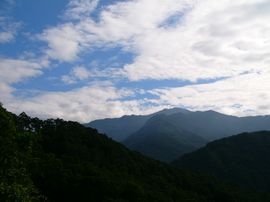|
|
|
||||||||||||||||||||||||
|
|
|
||||||||||||||||||||||||
|
|
|||||||||||||||||||||||||
|
|
|
||||||||||||||||||||||||
|
|
|
|
|
||||||||||||||||||||||
|
|
Exploration : The Formation of the Maolin Butterfly Valley
The Cause and
Formation of the Maolin Purple Butterfly Valley
In June 2003, an
internationally renowned butterfly researcher, Dick Vane Wnight
specifically introduced in his book, a publication of British
Museum, n
Being an excellent
geographical shelter, the Maolin Area has over a million of
milkweed butterflies fly with its paragliding-like purple wings
to the foot of Mt. Dawu, the so-called, “Holy Mountain” of the
Rukai and Paiwan tribes for shelter over the winter. In recent
years, those butterflies that flock to the Purple Butterfly
Valley in every winter are all taxonomically members of the
Danaidae. Approximately 80% of them are purple crow butterflies
which are embedded with velvet-like, purple spots around their
dark brown wings these include Euploea eunice hobsoni
(Blue-branded King Crow Butterfly), Euploea tulliolous (Dwarf
Crow Butterfly), Euploea sylvester swinhoei (Two-branded
Crow Butterfly) and Euploea mulciber (Striped Blue Crow
Butterfly). The rests are species of the Linnaeus which have
scattered water blue spots on their wings.
The Purple Butterfly
Value merely embraces Kaohsiung, Pingtung and lower
elevated mountain
areas of Taitung County in the southern part of Taiwan. Although
the purple crow butterflies belong to the common species that
are distributed
throughout the low elevated mountain areas in Taichung, they are
butterflies naturally incapable of enduring the cold as they
originated from the tropical zone. By this fact, they are forced
to migrate to the Purple Butterfly Valley every year to gain
shelter from the cold east northerly wind. Purple Butterfly
Valley is known for its strategic geographical position to offer
such shelter. It is located on the southern part below the
Tropic of Cancer below the altitudes of 500m. the nearly dried
up river ditches, and the possession of stable sources of water
and nectar plants (e.g. shiny bugleweed herb and Lantana camara)
offer a temporary habitat for the winter migratory butterfly.
The facts that the valley opening almost faces the south and the sheltering mountains in the north make it almost impossible for the east northerly wind to make its way into the valley. Although there is sufficient fats accumulated in the bodies of these butterflies to cater for the energy needs throughout the winter, water is still required to produce a biological reaction in turning the fats to energy. Hence, adequacy in water source is also a compulsory condition for the Purple Butterfly Valley. Reference: http://www.svtw.org.tw/~butterfly/pruple9.htm
http://www.butterfly.org.tw/newspaper_detail.php?sn=1504 |
||||||||||||||||||||||||
  |
|||||||||||||||||||||||||

 amely
“Butterfly”, of what he regarded as “An expected encounter in
Taiwan in the winter of 1971.” He then listed the Maolin Purple
Butterfly Valley and the Monarch Butterfly Valley
in Mexico as two of the largest “Winter Migratory Butterfly
Valleys” in the world. This prominently demonstrated the
preciousness and the ecological uniqueness of the Maolin Purple
Butterfly Valley.
amely
“Butterfly”, of what he regarded as “An expected encounter in
Taiwan in the winter of 1971.” He then listed the Maolin Purple
Butterfly Valley and the Monarch Butterfly Valley
in Mexico as two of the largest “Winter Migratory Butterfly
Valleys” in the world. This prominently demonstrated the
preciousness and the ecological uniqueness of the Maolin Purple
Butterfly Valley.